Lessons in LightNow with ego-boosting example photos!What is the most important accessory your camera can have? The answer is light – and the good news is that it’s free. Make no mistake, a photograph taken on an iPhone in gorgeous light will trump a photograph taken by a professional high-spec camera in ugly light. When you see amazingly beautiful photographs the question shouldn’t be, “What camera and lens did he use to grab that?” but “Where did he get that light!?”
The great thing about light is that it can be very generous. It can add depth immersing you in a two dimensional image. It can highlight moments and objects you wish to draw attention to, and impart greater significance upon them. It can wash away blemishes and expose ugly truths. And it can trigger an emotional response – be it aching nostalgia or a cold shudder. At the most basic light and shadow reveals and conceals. But to use it effectively you need patience. Sometimes you have to wait a fair while to get the best light, or awake at an uncomfortably early hour.
Here I am going to describe the different types of light that can be found and the best use to make of them. Again, think of these as handy tips that can be ignored by your own instinct or judgement – there are no hard and fast rules, and sometimes there’s no such thing as ‘bad light’, only the bad use of light.
We’ll start with that most magical of light – the thirty to forty minutes before and after sunset and sunrise known variously as ‘the golden hour’ or ‘the magic hour’. What look does this give you? Watch a Michael Bay film. Pretty much every daylight shot is filmed in the magic hour – or given heavy digital manipulation to make it look like it was. A better choice of film for varying forms of gorgeous light is Terrence Malick’s ‘Tree of Life’ and ‘Badlands’. Emmanuel Lubezki and Tak Fujimoto show an immense understanding of the possibilities of light – so much so that any shot you take from those films could serve as a superb photograph in its own right.
So how does this ‘magic hour’ work? Well, as the sun sits low on the horizon the rays it emits has to pass through a thicker depth of atmosphere. The increased density of the air scatters the blue wavelength of the spectrum, leaving the reds dominant. This leads to a richer, more golden light. The atmosphere also diffuses the light more, making the shadows soft, whilst the low angle creates long raking shadows. This is perfect for portraits, landscapes and general walk-around shots. However, it doesn’t benefit flower or flora photography as much as you’d think.
Here’s an example of the magic hour at work in a portrait of two friends of mine. Note the soft light giving a healthy glow to the face, the shadows commonly found around the eyes and along the nose and washed out and the colours are richer yet softer without the hardness of a noonday shot.
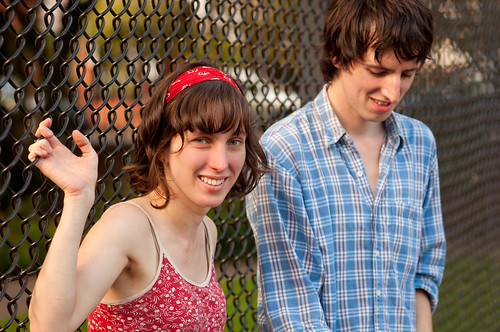
Naturally greater results can be achieved by shooting in the correct direction. With a low sun flaring on the lens becomes more of an issue. Backlit subjects can be difficult to expose correctly without fill-in flash. However, by very carefully shooting into the sun at a certain angle an interesting result can be obtained. This adds a more ethereal glow and lowers contrast throughout the image while increasing the highlights. This is called ‘contra’ shooting and is quite tricky to do, but rewarding. Depending on the angle the effect can vary in power, but here’s a modest example:
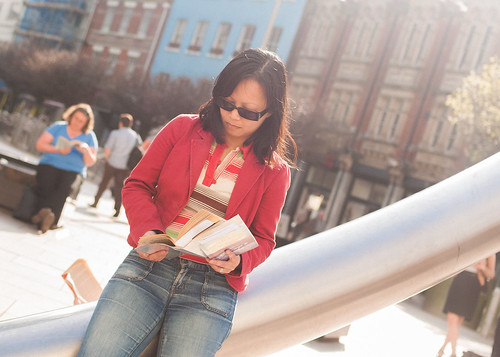
As I mentioned earlier, it is the raking light that lengthens shadows that is a key asset in magic hour. To make the most of it you have to train yourself to imagine what certain features will look like at certain times of the day. For example, if you walk past a fence and a tree it may look perfectly dull and commonplace in the daytime, but at sunrise or sunset the shadows it casts can frame subjects – be they people or objects. Sometimes it is useful to take a photograph in bad light to remind yourself to return later for a better opportunity - a visual notepad if you will.
This recessed drive-through ticketing window would look quite dull in round noon or in cloudy weather, but here with the golden, raking light it acquires depth and colour – the reds providing a warm glow to sink into while the eye fixes upon the green glass of the window. Note how the illuminated patch of wall creates a sort of arrow that leads the eye from left to right towards the point of interest. Visually Western cultures read left to right and the use of light stregthens that draw.
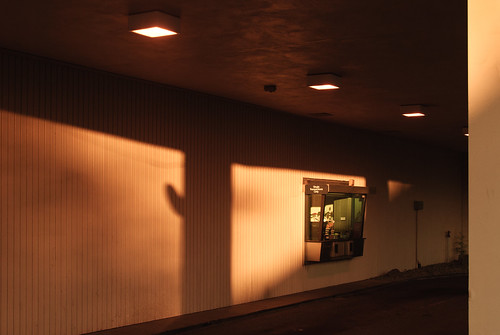
It is a happy fact that the long raking shadows aren’t cast by the facial features of portraits shot at this hour. The nigh-perfection of magic hour light can seem like a divine blessing.
Using this light does require patience and planning which leads me into the importance of patience in landscape photography. To get the best shots you must arrive early, which will usually be when the light is still bad – and sometimes the weather too. It’s no use looking out the window and noticing lush light and then deciding to hike up that hill to make use of it. By the time you get there it will invariably be gone. Instead, go out early and park yourself on the hillside. Set your camera ready to go now, don’t leave it to the decisive moment to fiddle with aperture and such. Even an overcast day can have breaks in the cloud, which can lead to magical moments.
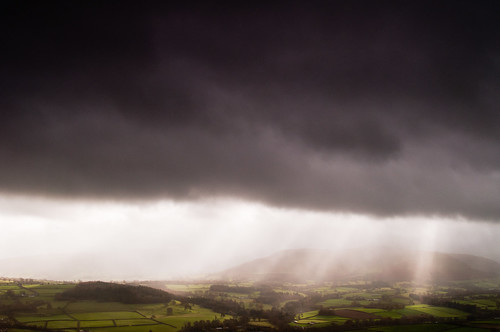
This image when reviewed on the LCD was only mildly impressive, but when working with Lightroom later on tweaking the contrast levels and a bit of burning and dodging brought the shafts of light out against the landscape.
Without ascending up Smith Rock in Oregon in thick mist I would never have been in the right place at the right time when the clouds broke and presented me with my two favourite shots of mist rolling into – and out of – a river canyon in a vast amphitheatre of softly glowing rock formations.
So we can take it that magic hour is a good thing. But what happens when you are robbed of shadow and the light is flat and hard. Well the brutal truth is that it makes interesting photography a lot harder, but it can still be done with luck. In these cases you have to go for broke on composition and interesting subject matter. The light in this image of a man sweeping up is incredibly boring and ugly. And yet it works for this image. Lacking a shadow the man is reduced of substance. The ugly concrete of the corporate building is hard and flat unrelieved by shadows or texture. It dominates the frame without relief. The square framing imposes a hard, emotionless classical feel that of a subject that is literally neither portrait or landscape. We are left with the sight of a man toiling like a worker ant, shrunken within an uncaring featureless environment. It’s one of my favourites and the light couldn’t have been worse for beauty, but better for complimenting the shot.
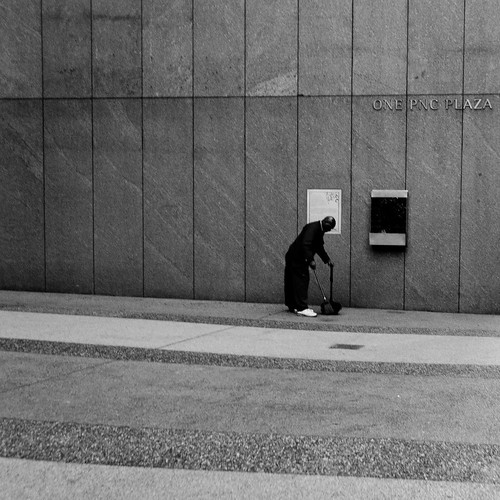
Hard light can destroy a photograph. Here’s an example of one I took in Reno of two colourful apartment buildings. Note the harsh over-brightness, the hard contrast and the lack of any shadows and the far too amped colours. It is in effect a tedious shot.
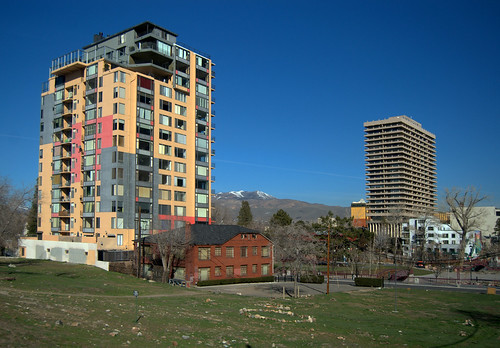
Sadly this is what you usually get when mad dogs and Englishmen shoot in the noonday sun. The lack of shadows destroys leading lines and makes anything but the simplest composition a meaningless clutter. On the portrait skin glistens unattractively, hair acquires a hard shine and contrast imposes deep shadows in the eyesockets. Furthermore, the intensity of the sun is such that everybody squints against the light bouncing off concrete or beating down from above. The best occassion to shoot in midday is – ironically – when the skies are clouded over. This diffuses the light. What effect does this have? Well, it makes the light softer. You still lack the shadows, but this is actually of great benefit for flower and macro photography where you’re concentrating on the shape and form and colour of the subject and where you don’t want petals casting shadows on the inner depths of the flower or the image of the bumblebee confused by a muddle of twig shadows cast over it.
Here’s an example of diffuse light in the form of a thick mist isolating a subject and providing an even but gloomy light that accentuates a kitchen sink feel. Black and white works very well with diffuse light and can be used to create quite an evocative feel.
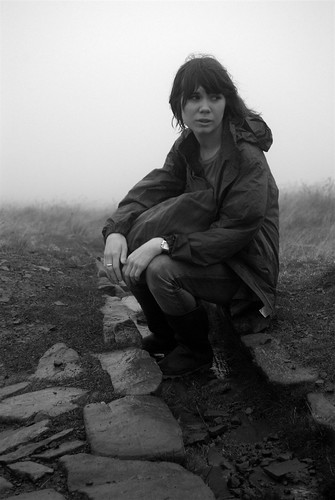
Mist and fog are naturally feted by photographers for their ability to isolate a subject. They also provide a chillier, more dream-like tone. In bright sunshine this shot taken in Breton Sculpture Park in Yorkshire would be a meaningless, pleasant landscape but with mist and shadowless light it acquires threatening and mysterious overtones.

In overcast conditions bereft of shadow shape becomes more important and photographs can become pleasingly simple in form. This simplicity is not usually reflected in nature and the human eye enjoys a simple, abstract view with few elements. In photography less is usually more. In this photograph I took in Germany the scene is filled with a flat light and the only elements are the snow, the trees and the house. This immediately conjures story. Who lives in the house? Are we ploughing through the snow to get there? It can be imbued with a fairy-tale atmosphere.
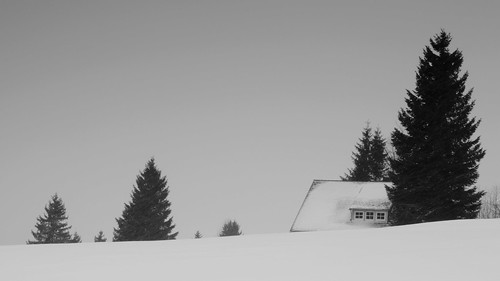
When it comes to the bulk of the day light is quite forgiving but not especially interesting of itself. It’s then that you think more about colour and composition. By no means write-off morning and afternoons, light is a good all-rounder and can still be pleasing. Subtle colour tints can be applied either way later in post-processing if you want to accentuate the image with a particular feel. Here’s an example of a opportunity from an aimless walk-around in the American town of Prineville.

Night time. A key feature of night is the lack of light. This occurs because we cannot see the sun. In essence, the sun rays are blocked from us, leading to a lack a light. It is light which we require to see and which we need so that things can be seen. Night.
Fortunate then that night does have sources of light independent of the sun. Here an interior light shines all alone in the night.
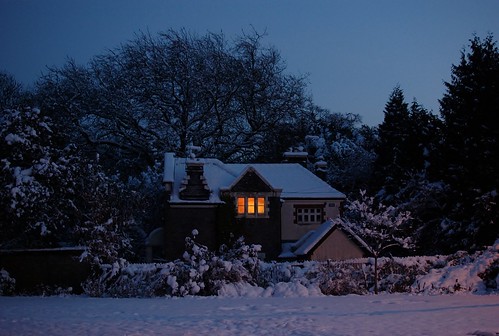
Here’s an odd thing though. Most quality night-time shoots occur in twilight while there is still that blue cast in the sky or in strong yet diffuse moonlight. In true night time conditions contrast increases dramatically, with independent light sources having very little transition between light and shadow. Witness Abraham Simpson walking away from camera through the pools of light cast by streetlamps. This can be evocative but it also plays merry hell with the camera sensor. Exposing for shadow means that light sources are burnt out or look harsh and clipped. Therefore it is better to shoot in twilight when there is still a little ambient light to play with. Another reason is that the light polution in cities casts a sometimes unwelcome sodium glare – especially when reflected off clouds. This is somewhat lessened in twilight and you can always take the image and darken the sky in post-processing if you wish for a true inky feel.
Again, night simplifies by concealing and it is simplicity that draws one in night-shots. Subjects are illuminated and there are few distractions.
Another tricky but rewarding feature is when subjects are backlit in low light conditions. This is hard to achieve naturally but can occur on such occassions as music gigs, urban nighttime street photography or dedicated portrait photoshoots. Here’s an image of DJ Jen Long. Note the hair illuminated from behind creates a pleasing halo. The lowlight forced a slower shutter speed and higher ISO, leading to grain. In this case it complements the scene.
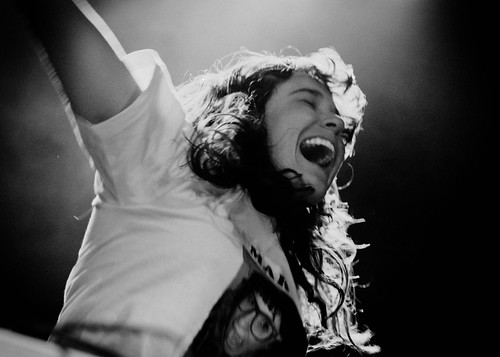
It isn’t just the quality and amount of light that has an impact upon a scene but the elements of contrast and transition. Two terms that cover this are ‘high-key’ and ‘low-key’ lighting.
High key lighting is a term given to a low ration of contrasts in light. It’s usually found in portrait photography and is usually an even, flattering light. It’s also beloved of early Hollywood where technical limitations meant in lighting meant that in lighting compositions had to be uncluttered – or that cluttered compositions had to be looked upon with a simple, even light. Usually time and money meant the former. Here it is found in a street photography photograph. Note the flat brightness isolating the main subject.
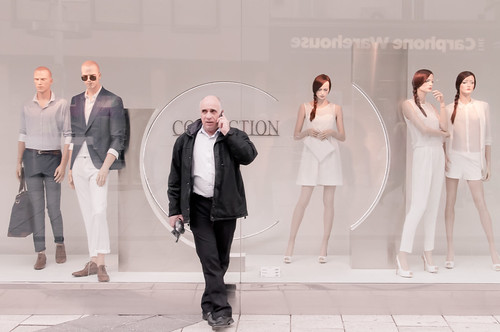
Low key lighting is somewhat more interesting. It consists of many transitions between light and dark, with a high contrast ratio. This can be used to illuminate elements you wish to draw the eye to while using dark elements to frame. In this photograph the dark shadows of the window frame box out the warm interior within the restaurant, while the bright lights draw the eye in and leave them with the faces of the people.
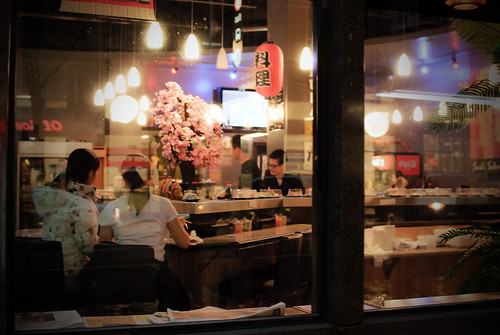
It also proves very evocative in portraits taken with limited, directional light – such as people lit by candle or window light. This was a staple of Vermeer and his school, where the boundaries of light and dark gave three-dimensional form to bodies and faces. With the higher contrasts it is called ‘chiaroscuro’ light. It leads to heightened drama and mystery. It usualy isn’t used in baby portraits. Here are two examples – a heavily Vermeer inspired portrait by window light and a more grungy and moody version with Thomas Truax, lit in very low light by nightclub spotlights.

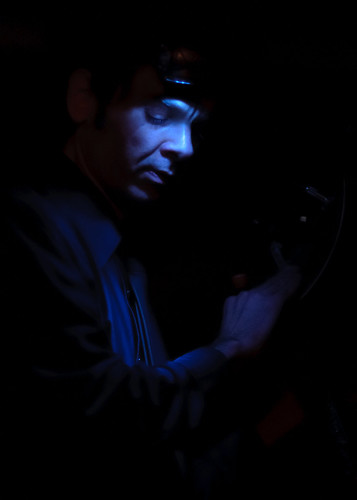
These then are the main forms of light. How you harness them is up to you. It is worthwhile however stopping to think of the sort of emotional impression you wish to give in a photograph and working out the best light for it. The complexity of light can hinder or benefit composition – just as composition can benefit or hinder the emotional response to forms of light. Again, these are guides rather than rules and mistakes in photography are many times more interesting than the products of rigid thinking. A glib rule oft used is to avoid shadows in portraits, yet as we can see above in low-key photography it can prove very evocative.
Next we shall be looking at composition and how it shall one day destroy your knees.

